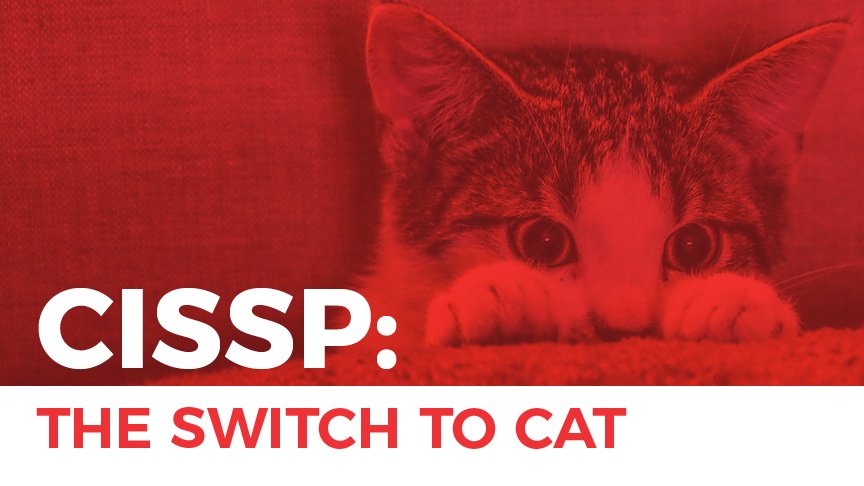CISSP: The Switch to CAT
I don’t have any cats. In fact, I’m allergic. But I do have a lot of experience with CATs. And this type of CAT is much more friendly to my immune system: Computer Adaptive Test. (ISC)² is converting CISSP into CAT according to a recent presentation by the organization’s CEO, David Shearer.
During my time at Kaplan Test Prep, CyberVista’s sister company, I oversaw the GRE course update to reflect the change to CAT, I worked with the team updating the NCLEX CAT-version course, and I have taken the CAT GMAT exam. This means I know how to build, how to best prepare, and how to successfully pass a CAT exam. Before we get into how to skin a CAT, let’s first discuss what a CAT exam actually is and what it means for you, the test-taker, on test day.
What is a CAT exam?
Just like some cats, a CAT exam really just wants to get to know you. The goal of a CAT exam is to evaluate a test taker’s true ability and knowledge level. It does this by “adapting” to the test-taker. That means it can analyze your answers and use that data to decide what question to feed you next, all in real time. For example, if you answer a question of intermediate difficulty correctly, your next question will be a bit more difficult. If you answer that intermediate question incorrectly, your next question will be easier. This process repeats after every question, and all of this zig-zagging allows the computer to precisely evaluate your skills and knowledge.
How Does it Work?
The computer decides if you pass or fail by using a rating called a competence level, which is basically your score range. The competence level gets more and more specific as the test goes along. As a test-taker, the goal is to keep this competence level above the passing threshold. The more difficult questions you answer correctly, the higher your competence level grows.
Click here to view an illustration of real-time CAT exam results.
A CAT exam can conclude in three ways:
- Pass/Fail: Your competence level was above or below the passing threshold.
- Run out of questions: This occurs when the maximum number of questions cannot determine whether your competence level is above or below the passing threshold.
- Run out of time: It gets a little complicated here.
- If you have not answered the minimum amount of questions, you fail.
- If you have at least answered the minimum amount of questions, the computer reviews your last x number of questions and decides whether you pass or fail.
What Does This Mean For You on Test Day?
There are a few characteristics of a CAT test that impact how you should prepare and approach the exam.
- Every Question Matters
- On a traditional, percentage-based 250-question exam, test takers can expect to concede questions. That means take a best guess and don’t get too caught up on one question. You don’t have that luxury with a CAT test. Every question matters because every question impacts your competence threshold. On a CAT test, it’s worth the extra time and effort to try and crack a difficult question.
- Early Questions Matter More than Later Ones
- Your competence level is shaped significantly by early questions. If you don’t do well in the early questions, then your competence level will go below the passing level and it will be hard to recover your competence level to above the passing threshold.
- You cannot go back and change answers
- Since a CAT exam is adaptive and responds to your answer with a new question, you cannot change an answer once you’ve selected it.
- Don’t Try to Out-Fox the CAT
- A common trap of taking a CAT test is to think along with the exam. For example, you know that if you answer a question incorrectly, the next question should be slightly easier than the previous one. Well, if you see an “easy” question then you may panic and think that you answered the previous question incorrectly. These thoughts take brain processing and an emotional toll. Leave the analyzing to the test engine.
- You can Fail Faster
- You can fail the exam after a predetermined number of questions are answered. It can be jolting for students to know that months of hard work can be evaluated by a computer in less than an hour. Again, don’t be intimidated by this and trust your knowledge.
What Does this all Mean?
Now that you know what a CAT exam is and you know it’s coming soon, what should you do about it? The first thing to do is take a deep breath. After that deep breath, you should consider accelerating your studies to take the CISSP exam before December of this year. We say that not because CAT isn’t conquerable, but because you’ve been preparing for the traditional exam format. Taking a CAT isn’t something you do without practice, or without an update to the test day strategies that you have learned.
If your schedule doesn’t allow you to take the exam by early December, no worries. But you will need help getting prepared for the CAT exam. Luckily, you can rely upon the experts at CyberVista who have the pedagogical experience of preparing many students for CAT exams. We are starting the process of rolling out our CISSP CAT test engine and CAT test day strategies so students can be fully prepared on exam day. As (ISC)² releases more information about the upcoming CAT, we will keep you posted.
CATs Don’t Bite
While all this may seem sudden, it’s not unprecedented. Tests change. We’ve seen this all before. I’ve lived this all before. We’re happy to help you earn your CISSP before or after the transition to CAT. Click here for more information on our online CISSP Training program and visit this page for the latest updates on the test change.


